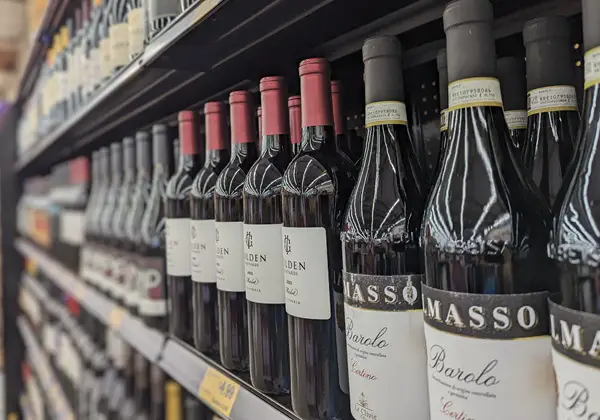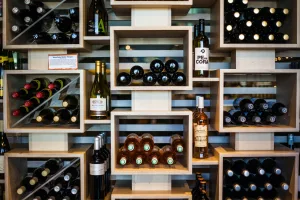Nebbiolo Wine Prices
| Category | Price Range |
|---|---|
| Entry-level | $10-$15 USD |
| Mid-priced | $15-$25 USD |
| Premium | $30-$50 USD |
| Super-premium | $50+ USD |
Nebbiolo, an Italian red wine, varies considerably in price. Entry-level Nebbiolo wines are $10-$15 USD. Mid-priced Nebbiolo wines are $15-$25 USD, premium Nebbiolo wines are $30-$50 USD, and super-premium Nebbiolo wines are $50+. Overall, Nebbiolo isn’t considered a cheap wine.
Here’s what you need to know about Nebbiolo wine price.
How Is Nebbiolo Wine Priced?

Nebbiolo, grown in northwestern Italy, is the main grape used in Barolo and Barbaresco wines but is also used to make red wines from Langhe. In general, Nebbiolo wines cost more than other Italian wines for two reasons: the Grapes and the Growers.
Why Nebbiolo Grapes Are Expensive
Nebbiolo grapes make pale, high-tannin, high-acid red wines. These wines need considerable time aging in the winery to soften them and integrate the structural components before they’re released for sale. Holding onto inventory increases operation costs. Those costs get passed onto the consumer, increasing the average bottle price of Nebbiolo.
Fun Wine Fact: If you see Barolo or Barbaresco on a wine label, these wines are Nebbiolo.
Nebbiolo Growers
Over the past century, many of Italy’s winegrowing regions have gone through consolidation. Small, independent grape growers or small families sold their vineyards to large, commercial operations or consolidated their efforts and joined cooperatives. This helps reduce production costs and lower the price of Italian wines made from these operations.
Fun Wine Fact: If you’ve ever held a bottle of Pinot Grigio Della Venezia that’s $7 USD, you’re witnessing the effects of this consolidation. These are solid, inexpensive white Italian wines that are rarely above $8-$10 USD – even on the export market, which is impressive.
Northwestern Italy is one of the holdouts for small grower-producers. A grower-producer owns the vineyard lands, farms the vineyards, and then also makes the wines. You may also hear the term “estate” wines, which is the same thing. Growing the grapes and making the wines increase overhead costs (and risks).
You find small-scale family operations growing Nebbiolo wines. This means the overall bottle price tends to be higher than your average, everyday, Italian wine.
Check out this quick guide to food pairing for Nebbiolo wines.
Is Nebbiolo Expensive?
Compared to other Italian red wines, Nebbiolo is expensive. It isn’t grown as widely as Sangiovese, for example. Small overall production area and higher production costs mean that you’ll pay more for Nebbiolo wines than other Italian reds.
Fun Wine Fact: Nebbiolo means “fog” in Italian, coming from either the foggy climate where the grapes are grown or the white powdery coating on the grapes before harvest that gives the appearance of fog.
Discover: Buying Italian wines can be a challenge. Here’s how to decrypt the Italian wine classifications – IGT, DOC, DOCG – which is better?
How to Buy Nebbiolo Wines

When shopping for Nebbiolo wines, here are a few tips to keep in mind:
- Barolo will be the most expensive. Barolo requires the longest aging regimen per the regions regulations. The grapes are from slightly cooler sites and come into the winery a little more tannic than other regions and need some time to mellow out, adding to production costs.
- Barbaresco will be mid-priced and less expensive than Barolo. The vineyards in this region enjoy warmer weather with earlier ripening and more approachable tannins and acid as younger wines, meaning they can be released for sale sooner.
- Langhe Nebbiolo offers everyday value for Nebbiolo wines. The Langhe region sits south of the Barolo and doesn’t share the fame and name recognition of its northern neighbor, but this is the best place to start with Nebbiolo wines, especially if you have a wine budget. Expect to pay $15-$25 for a Langhe Nebbiolo (you may find wines under $15 during promotional sales).
- Other Nebbiolo Regions: You can find Nebbiolo wines from Gattinara and Ghemme, for example, that are just north of Barolo in Italy, but you’ll need to go to a boutique wine shop to find them. You may also find small-production Nebbiolo from South Africa, California, and South America. This will be very small production, though, and probably not available at your average wine shop. So if you do come across these Nebbiolo wines, I encourage you to give them a try for a rare treat.
Personal Note: I typically will buy Langhe Nebbiolo wines and save Barolo’s for special occasions.
Thirsty for More?
What does Nebbiolo taste like?
What determines the price of a bottle of wine?
Ways to save money on wine (even the good stuff)
Nebbiolo vs Barbera
Complete Guide to Nebbiolo Food Pairing
Guide to Nebbiolo Cheese Pairing



